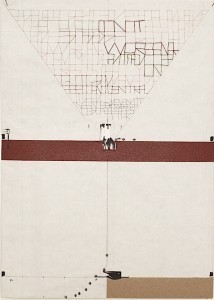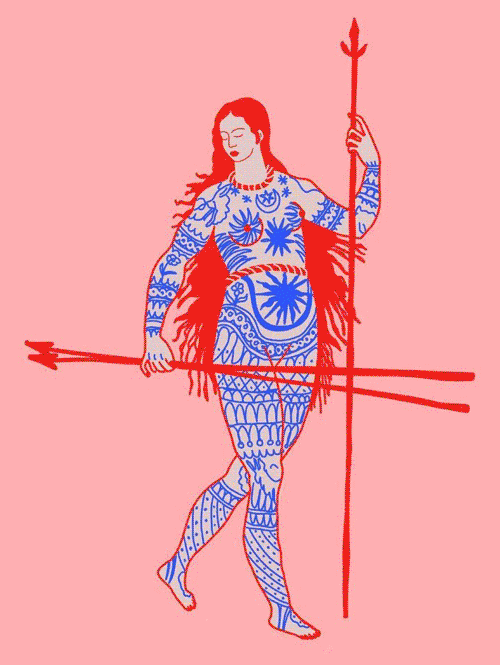Create an account
Welcome! Register for an account
La password verrà inviata via email.
Recupero della password
Recupera la tua password
La password verrà inviata via email.
-
-
- Categorie
- #iorestoacasa
- Agenda
- Archeologia
- Architettura
- Arte antica
- Arte contemporanea
- Arte moderna
- Arti performative
- Attualità
- Bandi e concorsi
- Beni culturali
- Cinema
- Contest
- Danza
- Design
- Diritto
- Eventi
- Fiere e manifestazioni
- Film e serie tv
- Formazione
- Fotografia
- Libri ed editoria
- Mercato
- MIC Ministero della Cultura
- Moda
- Musei
- Musica
- Opening
- Personaggi
- Politica e opinioni
- Street Art
- Teatro
- Viaggi
- Categorie
-
Maia Sambonet – Dismantled Geography
La galleria Alessandro De March presenta, nella temporanea sede di via Massimiano 25 a Milano ,la prima personale di Maia Sambonet,( Milano 1981). La recente serie di disegni di Maia Sambonet è un oggetto ibrido, che non sa decidere che forma prendere. Inquieti, mai fermi, uomini e cose si agitano sulla carta carbone.
Comunicato stampa
Segnala l'evento
Art is not nature, but is nature transformed by entering into new relationships where it evokes a new emotional response*. (John Dewey, The way beyond art, 1934)
La galleria Alessandro De March presenta, nella temporanea sede di via Massimiano 25 a Milano ,la prima personale di Maia Sambonet,( Milano 1981).
La recente serie di disegni di Maia Sambonet è un oggetto ibrido, che non sa decidere che forma prendere. Inquieti, mai fermi, uomini e cose si agitano sulla carta carbone. Sono disegni dove linee e corpo appaiono e scompaiono sul foglio. Lucciole in un prato bianco, grattano sulla superficie vetrata e inciampano nei bulloni. Tutto accade in scala ridotta: inconsapevoli dervisci scivolano in un mare di latte, metafora del vuoto, del pieno, della realtà in miniatura, vernacolare ironia di una vita come macinino da caffè. Disegnare è usare. Sulla superficie del disegno si assiste al dispiegamento dei codici dell’artista. Sono sillabe, lettere, segni, cuciture, tratti, figure che lentamente emergono dalla superficie fino a staccarsi definitivamente dalla superficie. C’è una matrice nucleare nei suoi lavori. C’è, in altre parole, una tensione verso una nuova definizione di spazio, le cui radici storiche affondano nella tradizione dell’avanguardia milanese, carica di maggiore inquietudine, mista poi ad un’atmosfera dell’illustrazione nordeuropea, un gotico caldo, che fa delle sue ambientazioni disegnate l’habitat ideale di hobbit metropolitani, che emettono segni prima che suoni. In quest’immaginario evanescente uno può leggere la dimensione dell’illustrazione, del collage, la superficie ruvida dell’informale, la precisione di mondi disegnati di Paul Klee, il delirio dell’anamorfosi del linguaggio, la serietà del gioco, il doppio senso munariano, ma anche il non senso dadaista e la attenzione per la messa in scena dell’opera e dell’artista stessi.
La serie ha infatti una struttura di una sequenza teatrale, di cui, solo alla fine, si legge il senso. Una tragedia senza catarsi, una parodia senza fine, un intrigo senza soluzione. Scritta nella lingua di Esopo, la favola di Maia è senza morale poiché nulla di-mostra. Al limite suggerisce. Dice che certe tecniche narrative, come il collage, la sceneggiatura, la scrittura, il disegno performance si trasformano e nel tempo riflettono la forma che assumono. Se le immagini si ascoltano, allora anche la vite si avvita al disegno. La ricerca è la terza dimensione come volontà di potenza, come liberazione dal peso dell’archivio e della memoria. Uno stato di emergenza, segnato dai radar, delle linee del cucito, dalle tante locazioni – collocazioni, che nei fogli lavorano come coordinate spaziali prive di centro. Un affaccendarsi di segni e di-segni, sputati fuori da una Valentina non più immagine della scrittura, ma puro strumento per scrivere, costruiscono un intreccio ora fitto ora rado, dove si muove il profilo di un corpo che esiste come collage di altri mondi. Finisce tutto in un teatrino, che nasce da una distruzione. Ciò che fa muovere l’ominide filiforme è infatti la carcassa di un ventilatore in ottone. Dalle ossa del marchingegno, l’artista – patologo riesuma quel che serve del corpo decadente e ne fa il motore di un’azione, tenuta insieme dal nastro della macchina da scrivere. E’ un teatrino come atto in potenza, di cui, da capo, il testo scritto ovvero la sceneggiatura che Maia stessa sente il bisogno di mettere giù, trattiene tutte le energie esplose o in-esplose.
Alla complessità che ha permesso tutto questo fare, si chiede il permesso di sparire. Al pensiero che ha costruito questo spazio sacro, si chiede con garbo di crollare. (Paola Nicolin)
english text
Art is not nature, but is nature transformed by entering into new relationships where it evokes a new emotional response*. (John Dewey, The way beyond art, 1934)
The Alessandro De March gallery, currently at its temporary premises in Via Massimiano 25, Milan, presents the first one-woman show of Maia Sambonet (Milan, 1981).
Maia Sambonet’s recent series of drawings is a hybrid object which is unable to decide which form to take. Restless, never still, men and things move about on the carbon paper. In these drawings, lines and bodies appear and disappear on the paper. Fireflies in a white field scratch the glass surface and trip up on the bolts. Everything takes place on a small scale: oblivious dervishes slip into a sea of milk, the metaphor of emptiness, of fullness, of reality in miniature, the vernacular irony of a life like a coffee grinder. Drawing means using. We observe the artist’s codes unfolding on the surface of the drawing. There is a nuclear matrix in her work. In other words, there is an urge towards a new definition of space, historically rooted in the tradition of the Milanese avant-garde, yet loaded with a greater disquiet; and mixed with an atmosphere of Northern European illustration, a warm gothic, which makes Sambonet’s drawn settings the ideal habitat for urban hobbits, who emit signs before sounds. In this evanescent imaginary, one recognises the dimension of illustration, of collage, the rough surface of the informal; the precision of worlds drawn by Paul Klee; the delirium of the anamorphosis of language, the seriousness of play; Munari’s double meanings, but also the non-sense of the Dadaists and an interest in the mise en scene of the work and the artists themselves.
The series does indeed have the structure of a theatrical sequence, the meaning of which is understood only at the end. A tragedy without catharsis, an unending parody, an unresolved intrigue. Written in the language of Aesop, Maia’s fable does not have a moral because it does not demonstrate anything. At most, it suggests. It says that certain narrative techniques such as collage, script-writing, writing or performance drawing change and, over time, come to reflect the form that they have taken. If images are listened to, then the screw is also screwed on to the drawing. Research is the third dimension, like a will for power, like a liberation from the weight of the archive and the memory. A state of emergency signalled by the radar, by the lines of stitches, by the many locations/collocations which work on the pages like spatial coordinates without a centre. A bustling of signs and de-signs, spat out of a Valentina (which is no longer the image of writing, but simply a writing instrument), construct a weave that is now dense, now sparse; in it moves the profile of a body that exists like the collage of other worlds. Everything ends up in a toy theatre, which is created out of destruction. What actually moves the spindly hominid is the carcass of a brass fan. From the bones of the contraption, the artist/pathologist sums up what is needed from the dying body, and turns it into the motor driving an action, held together by the typewriter ribbon. It’s a toy theatre like a potential action of which, again, the written text, or rather the script that Maia feels the need to write, holds in all of the exploded or unexploded energies.
We ask the complexity which allowed all this activity for permission to disappear. Politely, we ask the thought which built this sacred space if we can collapse.
(Paola Nicolin)
La galleria Alessandro De March presenta, nella temporanea sede di via Massimiano 25 a Milano ,la prima personale di Maia Sambonet,( Milano 1981).
La recente serie di disegni di Maia Sambonet è un oggetto ibrido, che non sa decidere che forma prendere. Inquieti, mai fermi, uomini e cose si agitano sulla carta carbone. Sono disegni dove linee e corpo appaiono e scompaiono sul foglio. Lucciole in un prato bianco, grattano sulla superficie vetrata e inciampano nei bulloni. Tutto accade in scala ridotta: inconsapevoli dervisci scivolano in un mare di latte, metafora del vuoto, del pieno, della realtà in miniatura, vernacolare ironia di una vita come macinino da caffè. Disegnare è usare. Sulla superficie del disegno si assiste al dispiegamento dei codici dell’artista. Sono sillabe, lettere, segni, cuciture, tratti, figure che lentamente emergono dalla superficie fino a staccarsi definitivamente dalla superficie. C’è una matrice nucleare nei suoi lavori. C’è, in altre parole, una tensione verso una nuova definizione di spazio, le cui radici storiche affondano nella tradizione dell’avanguardia milanese, carica di maggiore inquietudine, mista poi ad un’atmosfera dell’illustrazione nordeuropea, un gotico caldo, che fa delle sue ambientazioni disegnate l’habitat ideale di hobbit metropolitani, che emettono segni prima che suoni. In quest’immaginario evanescente uno può leggere la dimensione dell’illustrazione, del collage, la superficie ruvida dell’informale, la precisione di mondi disegnati di Paul Klee, il delirio dell’anamorfosi del linguaggio, la serietà del gioco, il doppio senso munariano, ma anche il non senso dadaista e la attenzione per la messa in scena dell’opera e dell’artista stessi.
La serie ha infatti una struttura di una sequenza teatrale, di cui, solo alla fine, si legge il senso. Una tragedia senza catarsi, una parodia senza fine, un intrigo senza soluzione. Scritta nella lingua di Esopo, la favola di Maia è senza morale poiché nulla di-mostra. Al limite suggerisce. Dice che certe tecniche narrative, come il collage, la sceneggiatura, la scrittura, il disegno performance si trasformano e nel tempo riflettono la forma che assumono. Se le immagini si ascoltano, allora anche la vite si avvita al disegno. La ricerca è la terza dimensione come volontà di potenza, come liberazione dal peso dell’archivio e della memoria. Uno stato di emergenza, segnato dai radar, delle linee del cucito, dalle tante locazioni – collocazioni, che nei fogli lavorano come coordinate spaziali prive di centro. Un affaccendarsi di segni e di-segni, sputati fuori da una Valentina non più immagine della scrittura, ma puro strumento per scrivere, costruiscono un intreccio ora fitto ora rado, dove si muove il profilo di un corpo che esiste come collage di altri mondi. Finisce tutto in un teatrino, che nasce da una distruzione. Ciò che fa muovere l’ominide filiforme è infatti la carcassa di un ventilatore in ottone. Dalle ossa del marchingegno, l’artista – patologo riesuma quel che serve del corpo decadente e ne fa il motore di un’azione, tenuta insieme dal nastro della macchina da scrivere. E’ un teatrino come atto in potenza, di cui, da capo, il testo scritto ovvero la sceneggiatura che Maia stessa sente il bisogno di mettere giù, trattiene tutte le energie esplose o in-esplose.
Alla complessità che ha permesso tutto questo fare, si chiede il permesso di sparire. Al pensiero che ha costruito questo spazio sacro, si chiede con garbo di crollare. (Paola Nicolin)
english text
Art is not nature, but is nature transformed by entering into new relationships where it evokes a new emotional response*. (John Dewey, The way beyond art, 1934)
The Alessandro De March gallery, currently at its temporary premises in Via Massimiano 25, Milan, presents the first one-woman show of Maia Sambonet (Milan, 1981).
Maia Sambonet’s recent series of drawings is a hybrid object which is unable to decide which form to take. Restless, never still, men and things move about on the carbon paper. In these drawings, lines and bodies appear and disappear on the paper. Fireflies in a white field scratch the glass surface and trip up on the bolts. Everything takes place on a small scale: oblivious dervishes slip into a sea of milk, the metaphor of emptiness, of fullness, of reality in miniature, the vernacular irony of a life like a coffee grinder. Drawing means using. We observe the artist’s codes unfolding on the surface of the drawing. There is a nuclear matrix in her work. In other words, there is an urge towards a new definition of space, historically rooted in the tradition of the Milanese avant-garde, yet loaded with a greater disquiet; and mixed with an atmosphere of Northern European illustration, a warm gothic, which makes Sambonet’s drawn settings the ideal habitat for urban hobbits, who emit signs before sounds. In this evanescent imaginary, one recognises the dimension of illustration, of collage, the rough surface of the informal; the precision of worlds drawn by Paul Klee; the delirium of the anamorphosis of language, the seriousness of play; Munari’s double meanings, but also the non-sense of the Dadaists and an interest in the mise en scene of the work and the artists themselves.
The series does indeed have the structure of a theatrical sequence, the meaning of which is understood only at the end. A tragedy without catharsis, an unending parody, an unresolved intrigue. Written in the language of Aesop, Maia’s fable does not have a moral because it does not demonstrate anything. At most, it suggests. It says that certain narrative techniques such as collage, script-writing, writing or performance drawing change and, over time, come to reflect the form that they have taken. If images are listened to, then the screw is also screwed on to the drawing. Research is the third dimension, like a will for power, like a liberation from the weight of the archive and the memory. A state of emergency signalled by the radar, by the lines of stitches, by the many locations/collocations which work on the pages like spatial coordinates without a centre. A bustling of signs and de-signs, spat out of a Valentina (which is no longer the image of writing, but simply a writing instrument), construct a weave that is now dense, now sparse; in it moves the profile of a body that exists like the collage of other worlds. Everything ends up in a toy theatre, which is created out of destruction. What actually moves the spindly hominid is the carcass of a brass fan. From the bones of the contraption, the artist/pathologist sums up what is needed from the dying body, and turns it into the motor driving an action, held together by the typewriter ribbon. It’s a toy theatre like a potential action of which, again, the written text, or rather the script that Maia feels the need to write, holds in all of the exploded or unexploded energies.
We ask the complexity which allowed all this activity for permission to disappear. Politely, we ask the thought which built this sacred space if we can collapse.
(Paola Nicolin)
18
settembre 2009
Maia Sambonet – Dismantled Geography
Dal 18 settembre al 07 novembre 2009
disegno e grafica
Location
GALLERIA ALESSANDRO DE MARCH
Milano, Via Massimiano, 25, (Milano)
Milano, Via Massimiano, 25, (Milano)
Orario di apertura
martedi - sabato 12.00 / 19.00
tuesday - saturday 12.00 pm. - 7.00 pm and by appointment
Vernissage
18 Settembre 2009, ore 18
Autore









